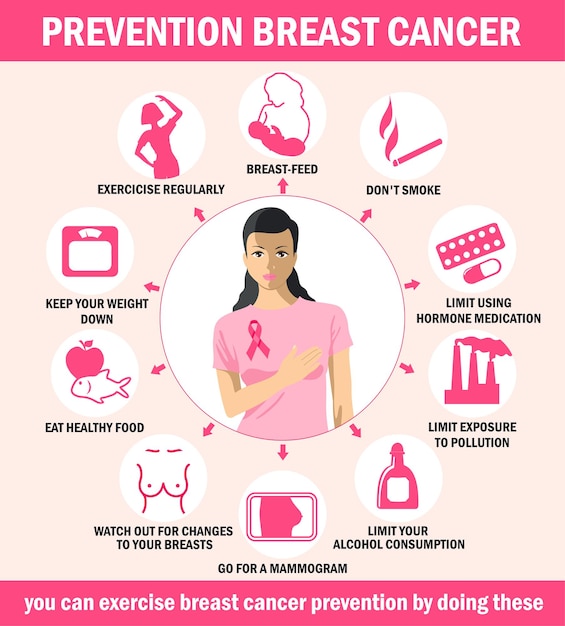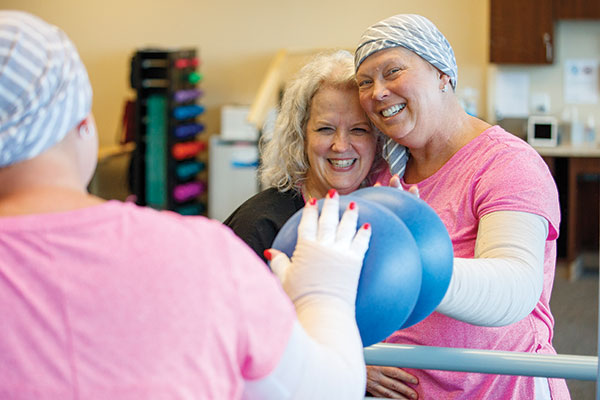

What is Breast Cancer?
The disease forms when breast cells mutate (change) and multiply uncontrollably, forming a tumor. There are different kinds of breast cancer. Two common types of breast cancer are invasive ductal carcinoma and invasive lobular carcinoma. Invasive ductal carcinoma, the cancer cells begin in the ducts and then grow outside the ducts into other parts of the breast tissue. Invasive lobular carcinoma the cancer cells begin in the lobules and then spread from the lobules to the breast tissues that are close by. If either are left untreated, the cancer cells may spread to other parts of the body.
The cause of breast cancer is unknown but could be linked to a genetic mutation in two genes, BRCA1 and BRCA2 (the "breast cancer" genes), which are tumor suppressor genes. When working properly they produce proteins that keep cell growth in check, but mutations can render these genes inactive.
Breast cancer is the second leading cause of female cancer deaths and the lifetime risk of developing breast cancer for women in the United States is 1 in 8. 70% of all breast cancers presenting in women over the age of 50. Fewer than 1% of breast cancers occur in males.

Some general symptoms may include:
Signs that breast cancer has spread to bone:
Signs that breast cancer has spread to lungs:
Signs that breast cancer has spread to liver:
Signs that breast cancer has spread to brain:
Before surgery, physical therapy can help. Prehabilitation has shown to improve psychological and physical outcomes of the treatment.
Post-Surgical Rehabilitation
The goal of physical therapy after surgery and during cancer treatment is to minimize surgical side effects and optimize function.
Physical Therapy for Lymphedema
What is the Prognosis of Breast Cancer?
Prognosis is dependent on when the lump is discovered, how large it is and involvement of lymph nodes.
Breast cancer can happen in your 20s and 30s and have lower survival rate than older women because routine screening is not recommended for this age group.
The 5-year relative survival rate for localized breast cancer, which is only in the breast, is 99%. Regional breast cancer is cancer that has spread to nearby tissue or lymph nodes and the 5-year relative survival rate is 86%. The 5-year relative survival rate for distant breast cancer that has spread to other parts of the body is 28%. Breast cancer can reoccur in 20% to 25% of women.
A mammogram should be done annually beginning at age 45 to 54 years of age. All adult women are encouraged once a month to perform a self breast exam.

Impact of breast cancer on overall health:
Breast cancer and treatment may change how you feel about your body leading to negative thoughts or depression. Fatigue is common, hair loss, bone thinning causing joint pain, scaring for surgery, weight gain or loss, sexual side effects, hot flashes and changing in sensation.
Breast Cancer and Physical Therapy
Physical Therapy can help with breast cancer treatment before, during, and after. Some ways PT will help could be by completing evaluations. Some common evaluations completed are:
Looking at any pain complaints
ROM (range of motion)
Posture
Strength
Joint Movement
How the surgery site is healing
Nerve Movement
After breast cancer surgery, breast reconstruction, or radiation therapy to the breast or chest wall the patient might find it hard and painful to lift their arm above their head or behind their back. PT exercises are designed to restore these movements and reduce pain. Physical therapists create treatment plans that use physical activity to help cancer survivors manage side effects of treatment and cancer-related problems, improve their health and function, and return to work and other activities. PT's are movement experts that improve quality of life through hands-on care, patient education, and prescribed movement.
Lymphedema
Lymphedema is caused when lymph nodes are removed or damaged by cancer surgery, the disease itself, or effects of radiation. It presents as swelling caused by a buildup of lymph. Lymphedema can be uncomfortable and painful, it may also lead to infections over time. A trained lymphedema PT can help to drain the fluid from the area, complete short stretch compression bandaging, and skin care.

https://www.lbbc.org/learn/living-breast-cancer/body-image/how-breast-cancer-impacts-your-body-image#:~:text=Breast%20cancer%20and%20its%20treatment,were%20prepared%20for%20side%20effects.
https://www.cancercenter.com/community/blog/2019/05/physical-therapy-after-breast-surgery
https://n2physicaltherapy.com/b/the-role-of-physical-therapy-in-breast-cancer-rehabilitation
https://www.cedars-sinai.org/health-library/diseases-and-conditions/p/physical-therapy---breast-cancer.htm
https://www.breastcancer.org/symptoms/understand_bc/statistics
Catherine C. Goodman & Charlene Marshall. Pathology For The Physical Therapist Assistant. Saunders; 2nd edition (December 23, 2016)
